Chris Baty's Blog, page 90
November 16, 2018
3 Things Authors Should Know About Publishing

Every year, we’re lucky to have great sponsors for our nonprofit events. Now that we’re halfway through the month, you may be wondering what to do with your novel when (definitely when, not if!) you finish your novel draft. Today, IngramSpark, a NaNoWriMo 2018 sponsor, has some tips if you’re thinking about publishing:
Taking the leap from writer to published author is the end goal majority of writers have for their work. We all write for different reasons, are motivated by myriad factors, experiences, characters, and pursue various genres and plotlines, but once the writing is finished, we generally all want the same thing: to share our work with others. So if you’re considering publication for your writing, here are a few things to keep in mind.
Gone are the days when traditional publishing was the only way that “real” authors could publish their work. With advancements in experience, technology, industry acceptance, and reader enthusiasm, independent publishing has become an increasingly viable option. With the right printing and distribution, your book can look the same as any produced by traditional publishers with the same availability (and you can also skip the gatekeepers, maintain creative control, and receive higher earnings per book sale). Keep in mind, that independent publishing will require you to seek help from a professional editor, book designer, and be willing to dive into your own book marketing, but all of these are easily accessible to indie authors and well worth the return on investment when you publish professionally.
2. Never Limit Your Book’s Potential ReachIf a reader wants to read your book, your book should be available to them. It’s as simple as that. You don’t know how readers will want to consume your content, so be sure it’s offered in print and ebook formats. Why exclude those who ONLY read print books or ONLY read ebooks? Your reader may shop exclusively at their local independent bookstore; they may only shop for books online; or they might even leave their book discovery to libraries. Make sure your distribution doesn’t exclude any of these outlets. You never know who will want to buy your book; it may even end up being highly popular to those in a country other than your own. Make sure when you publish your book, your potential reach isn’t limited, globally or by distribution channel, so as not to exclude any potential readers from buying your book.
3. Education is KeyThe most successful authors and publishers are the ones who understand the publishing process, the publishing industry, and their audience. If any of these pieces are missing, your book can’t reach its full potential. If you’ve created a work that matters to you and you genuinely want to share it, you owe it to yourself and your book not to slack in these essential areas. Do your research to understand:
what kind of editing or design your book may needthe appropriate timeline for production and promotionwhat booksellers and libraries need from you and your book in order to carry itwhat kind of media coverage you can getwhat month is best to publish a book like yourswhat books similar to yours look likehow much they sell forand what keywords you may want to sprinkle into your book description to attract your target readersAll of these pieces are important to producing the best book you can, and the information is available to you.
All that stands between you and the publication of your book is a means to publish professionally, a way to ensure your book is shared widely, and the willingness to learn how to make your book a success (ideally, all within a reasonable price range to make sure your efforts pay off). These things seem like a much lower barrier to entry than what is offered by the traditional publishing process, considering how much time and effort you dedicate to convincing others your book is worthy before ever seeing a dime. Independent publishing isn’t for everyone, but neither is traditional publishing, so it’s always good to be aware of your options and fully explore what’s right for you and your book.
About IngramSparkIngramSpark is an award-winning independent publishing platform, offering indie authors and publishers the same fully-integrated print and digital products and global distribution enjoyed by big-time publishers. Once you finish and format your book, IngramSpark makes it possible to share it with the world, allowing you to focus on creating innovative content while we do the rest: print, ship, and distribute.
In 2017, the Author’s Guild awarded IngramSpark for Distinguished Service to the Literary Community, alongside Toni Morrison and James Patterson, which speaks to our focus on supporting the author not only as a printer and distributor, but as a resource for overall publishing success.
If you’d like to learn more about how IngramSpark supports you produce quality publications, achieve global distribution, and access free resources to help you publish successfully, please visit our website.
All NaNoWriMos receive FREE title setup on print or ebooks (and free revisions) with IngramSpark until March 31, 2019, with promo code NANO. Write with NaNoWriMo, publish with IngramSpark.
Regardless of how you decide to pursue your publication goals, may your writing accomplishments be validated and your words well-read!
Top photo by Nicole Honeywill on Unsplash.
30 Covers, 30 Days: Day Sixteen
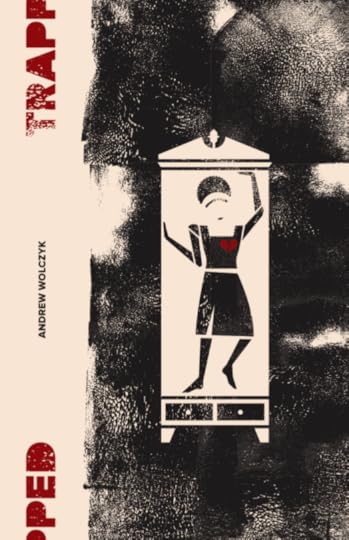
Every November, during National Novel Writing Month, thirty professional designers volunteer to create book cover art inspired by novels being written by aspiring authors from around the globe. Why? To encourage new, diverse voices, and help build a more creative world.
30 Covers, 30 Days is presented in partnership with designer and author Debbie Millman. Read more about these NaNoWriMo 2018 novels-in-progress, and the cover designers, below.
TrappedA Thriller novel being written this November by NaNo participant Andrew Wolczyk in the United Kingdom.
Abigail Palmer, newly widowed and desperate to escape her grief, takes a holiday. Booking herself into a luxury apartment she cuts herself off from the outside world. This turns out to be a mistake when she finds herself trapped in a cupboard.
Her son, Joel, unable to contact her, suspects there is a problem and starts a mad rush to find out where she is holidaying. Will he be in time to save his mother before she dies of starvation and lack of water? Not to mention her air is running out.
Cover designer Joshua Ege shared this mockup of what Trapped would look like as a physical book:
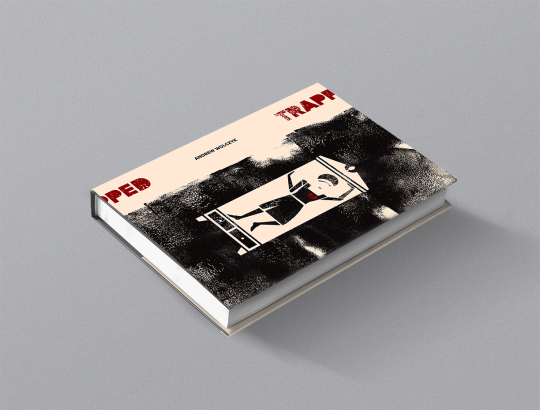
Stay tuned for new covers every day of the month!
Cover Designed by Joshua Ege
Joshua Ege is an Assistant Professor of Visual Communication at Texas A&M University-Commerce. Joshua has served on the board of directors of the Dallas Society of Visual Communications (DSVC) for 13 years and is the current the President of the DSVC Foundation. His affinity for visualization of concept is only overshadowed by his love of family, friends and his daily interactions with mankind. His work has been recognized by Print Magazine, HOW, GD USA, Art Directors Club of Houston, DSVC, Logo Lounge, Communication Arts and Harper Collins publications among others. He can occasionally be found on twitter @joshege, and on his website www.joshuaege.com.
November 15, 2018
3 Tips from an Engineer to Help You Write Efficiently

For many, writing is an art — but you can still use science to make the most of November and meet your word count goals (and then some)! Today, writer and engineer Benjamin M. Weilert shares how he used spreadsheets to become a more efficient writer:
I’m an engineer. While most of my colleagues use this as an excuse to keep themselves from writing anything, I argue it’s the reason they need to be the best writers. The concepts engineers can create in their minds still need to be communicated to the world, and they’re sometimes concepts never imagined before.
Similarly, how many writers are out there with an idea nobody has ever read, just waiting to get it onto the page? As an engineer, I have a particular set of skills — some would say “quirks” — that have helped me over the last eight years of NaNoWriMo grow from just barely finishing to writing rapidly and voluminously.
Most engineers are known for their problem-solving skills, and NaNoWriMo presents an interesting problem: how do I write 50,000 words of a novel in 30 days? Like with most engineering problems, I resort to spreadsheets. After all, I’m already writing the book in Microsoft Word, so it’s not hard to set up an Excel spreadsheet to track my progress. This spreadsheet is what helped me grow as a writer. Here’s how tracking my writing helped motivate me to become a better (or at least faster/more efficient) writer:
#1: 1,667 words are the minimum.My spreadsheet doesn’t allow me to slack. If the “words written” column for that day is less than 1,667 words, I have to keep writing. I may be 15 days ahead, but until I get those 1,667, I can’t stop writing for that day. Here’s how the spreadsheet looks:
 #2: Compete with the past.
#2: Compete with the past.What’s nice about a spreadsheet that tracks your NaNoWriMo progress for one year is that it can be used to track your progress for the following years as well. Consequently, I’m always looking at ways to outdo myself each year, whether it’s being further ahead than in previous years, writing more per-day, or writing more than ever before. It’s how I was able to reach 50K in less than two weeks (four times), write over 10K words in a day (in six years), and even reach my record of 123,456 words in a month. No matter what your own goals and records are, by tracking them day to day and year to year, you’ll manage to write more!
#3: Recognize trends.As I began to track my NaNoWriMo projects against each other, I started to see trends. I saw that I would usually write a lot during the Veteran’s Day weekend (since I get Veteran’s Day off). I also saw that I would get almost no writing done around Thanksgiving (since I travel out of town for it). Recognizing which days and situations were conducive to my writing helped me to schedule them out in advance so I’d be sure to use them to their utmost capability. Think about the trends in your life, and see how they impact your writing!
In the end, my spreadsheet allowed me to recognize the small — sometimes hidden — milestones that can give me a push to keep writing. For instance, last year, it helped me see how close I was to 500,000 cumulative words. I’m extra motivated to beat a previous “high score” day from a past NaNoWriMo.
Milestones like these are what made me realize that the impossible feats of veteran writers are actually quite achievable if you break them down into smaller chunks. And what engineer wouldn’t tackle a problem by first breaking it down into manageable pieces? But don’t take this engineer’s word for it; try it for yourself!

Benjamin M. Weilert is a verbal and visual artist from Colorado Springs, Colorado. He’s been winning NaNoWriMo since 2010, combining his love and knowledge of science with his writing. His first three projects, The Fluxion Trilogy, are what he likes to call “hard science in a fantasy candy coating.” His latest book, Fourteener Father, is a memoir of his adventures climbing Colorado’s 14,000 ft. mountains with his dad. You can follow him on Facebook, Twitter, YouTube, and Goodreads, or check out his writing website.
30 Covers, 30 Days 2018: Day Fifteen

Every November, during National Novel Writing Month, thirty professional designers volunteer to create book cover art inspired by novels being written by aspiring authors from around the globe. Why? To encourage new, diverse voices, and help build a more creative world.
30 Covers, 30 Days is presented in partnership with designer and author Debbie Millman. Read more about these NaNoWriMo 2018 novels-in-progress, and the cover designers, below.
The IslandA Science Fiction novel being written this November by YWP participant Noel Simmins in the United States.
Fifty seven years ago, the fighting stopped. The wars ended. Why? Well, there weren’t enough people left to fight. The human race was on the verge of extinction, and it’s a very lucky thing that we have not gone extinct. Not yet, at least. So, while the rest of the world is full of anarchy, and poverty, the scientific community came up with a way to keep us from going extinct. The Island Project.
Twice a year, a boat delivers a group of teenagers to an Island. The Island is safe. The teens must learn to survive if they are to save the word from extinction. The project is five years old, and, so far, has gone by without a hitch. The test subjects have developed traditions, and a bit of a new culture. They are doing quite well.
Until now. Boats have been sighted far too close to the shores of The Island, and they are not our boats. There have been rumors of pirates, looking to attack The Island for the test subjects’ resources. And, a girl showed up on the beach this morning. She claims to have no memories, and while the test subjects seem to be trusting her, I am not sure that is what is best for their survival. For the survival of humanity. Unfortunately, I am not allowed to speak with them for another four and a half months. I can only hope they will survive that long.
-From the journal of Dr. Janice Peters
Cover designer Alexandra Alcantara shared these sketches from the design process:
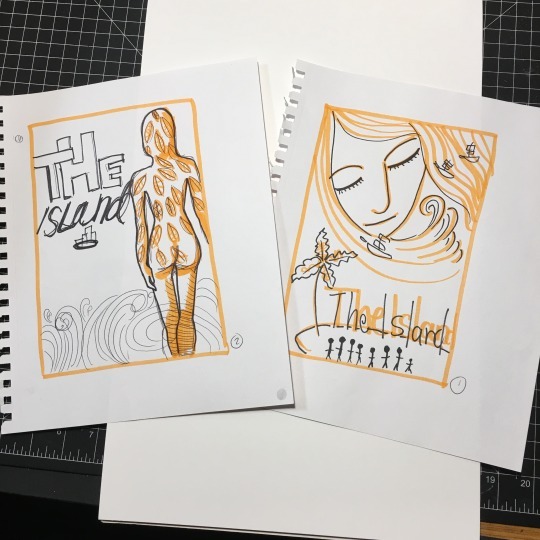
Stay tuned for new covers every day of the month!
If you’re interested in entering your novel to the 30 Covers, 30 Days program, check out the instructions here. Don’t forget, today (November 15) is the last day to submit covers.
Cover Designed by Alexandra Alcantara
A
lexandra is a Raleigh, NC based Designer, originally from NYC. When not working on presentations for her clients, she is hard at work on her personal projects for children’s toys and games. She is currently working on a new children’s series that she hopes to bring to the mobile gaming space. She is also an animal lover and advocate, she shares a home with her husband, 5 dogs and a cat. Much of her personal work is in the political landscape, animal welfare and children.
You can follow her on Instagram @Asquaredcreative and AsquaredCreative.com.
November 14, 2018
“Writing a book is one of those things you always wanted to do,...
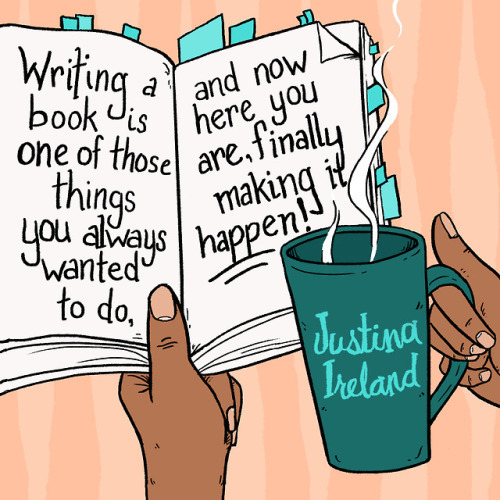
“Writing a book is one of those things you always wanted to do, and now here you are, finally making it happen!” —Justina Ireland
Our amazingly multi-talented Customer Service Captain, Wesley Sueker, has illustrated quotes from this year’s Pep Talks! Check out Wesley’s other work on DeviantArt, and read the rest of Justina Ireland’s pep talk here.
30 Covers, 30 Days 2018: Day Fourteen
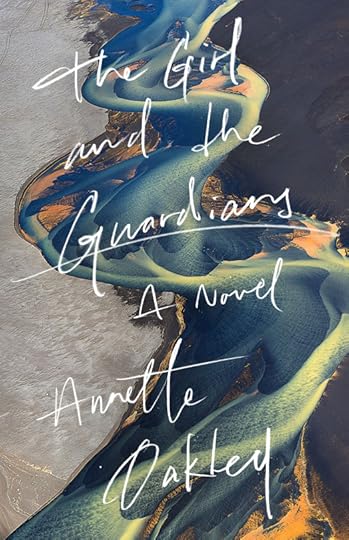
Every November, during National Novel Writing Month, thirty professional designers volunteer to create book cover art inspired by novels being written by aspiring authors from around the globe. Why? To encourage new, diverse voices, and help build a more creative world.
30 Covers, 30 Days is presented in partnership with designer and author Debbie Millman. Read more about these NaNoWriMo 2018 novels-in-progress, and the cover designers, below.
The Girl and the GuardiansAn Experimental novel being written this November by NaNo participant Annette Oakley in the United States.
Ellie Sigurd’s always been intrigued by her Icelandic heritage. She’s read books, took basic Icelandic in university, and scoured the web for photos, but she’s never been allowed to visit. Every time she’s tried, her family has shut her down, refusing to tell her anything about her history–not even her grandfather’s name.
They’re scared and superstitious, and she doesn’t know why.
After graduating from university, Ellie rebels, taking a solo trip to Iceland to pursue answers to the life-long questions she’s had about her heritage. It’s there she meets Katla Rosenburg, a wild, adventure-loving native with dreams of taking a “road trip to end all road trips” around the country. She talks Ellie into letting her tag along as a local guide, and it’s fabulous and fun … until things start to go wrong.
Ellie discovers her grandfather was murdered, despite what authorities had claimed for years. Locals talk about a family curse–an ancient bargain with the land spirits they claim she must fulfill. Katla starts to grow distant and warns Ellie to never stray from the main road. And then there’s the wooden doll of an old woman following her wherever she goes, begging her to pick it up…
Begging to show her that sometimes, the folklore women tell their children to keep them in bed at night? It’s all real … and coming for her.
Cover designer Richard Ljoenes shared an alternate cover version and some notes about the design process:
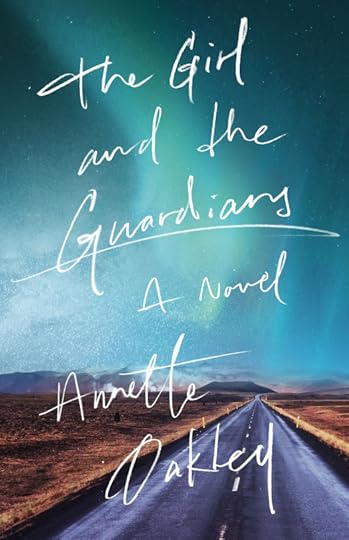
“The photograph is by Russian photographer Andre Ermolaev. It depicts a Volcanic river in Iceland. I thought the beauty and forcefulness of it was a perfect way to capture not only the dramatic Icelandic scenery throughout the book, but also old Icelandic folklore and the violent family curse—the ancient bargain with the land spirits. I hand-lettered the type to be somewhat fitting of young person and their journal entries during the main event—the road-trip through this raw and rugged land.
Outtakes included designs using photos of Icelandic mountain roads against the backdrop of Aurora Borealis, which also suggested some of the spiritual/supernatural qualities of the story, but ultimately felt a bit too familiar.”
Stay tuned for new covers every day of the month!
If you’re interested in entering your novel to the 30 Covers, 30 Days program, check out the instructions here. Don’t forget, November 15 is the last day to submit.
Cover Designed by Richard Ljoenes
Richard Ljoenes is a Designer and Art Director based in New York City. He primarily works on book covers and illustrated interiors, but his background also includes advertising and corporate identity. Ljoenes’s design and art direction has been awarded and recognized by The One Show, Type Directors Club, Communication Arts, The Cannes Lions Awards, Art Directors Club, Graphis, Print Magazine, How Magazine, and Graphic Design USA who named him a designer to watch in 2018. He has worked on over fifty New York Times Bestsellers. Ljoenes currently runs his own studio and is available for projects.
You can find Richard online at www.richardljoenes.com and on Instagram @richardljoenes.
November 13, 2018
Pro Tips from a NaNo Coach: Write Where the Heat Is
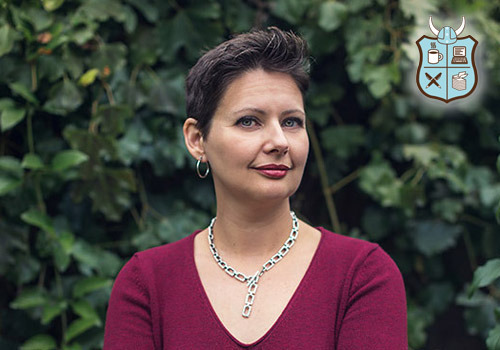
NaNoWriMo can seem like a daunting task sometimes, for NaNo newbies and veterans alike. Fortunately, author Carolina De Robertis is here to share her advice on how to overcome some of NaNo’s obstacles:
Something that never ceases to amaze me about writing: it can be our greatest refuge, and, at the same time, one of the most frightening things we ever do. It’s a space that, for better or worse, is entirely ours to shape, to define. The blank page can welcome and reflect us like nothing else in the world, and yet, at the same time, all that blank space can make self-doubt rise up and overwhelm us.
I’ve written four novels now, and I can tell you that this dynamic continues on, because even when you’ve finished a book before, creating a new novel means diving yet again into the unknown. I joined NaNoWriMo when I was already a published author, back in 2011, to write an early rough draft of my third novel, The Gods of Tango. Yes, it took me four more years after completing NaNoWriMo to expand, research, revise, and polish the book. Yes, those stages do come after the sweet thrill of crossing that 50,000 word finish line. But the power of NaNo lies, in part, in compressing time to make you swim forward even though you don’t know where you’re going, to make the voice of self-doubt shut up and let you write.
So, for now, be bold.
For now, ride the NaNo flow as if it were a great roaring river, the pure exhilaration of the journey enough to keep you going, splashed, drenched, gliding on a story that is yours and yours alone.
If you’ve got momentum, fantastic. Trust it. Let it carry you.
If you start feeling stuck, here are a few techniques that I’ve offered in the past to creative writing students, as well as used myself:
1. Key into Burning Questions.Set aside 20 minutes to brainstorm the burning questions you’re carrying about your book, and the questions you want the book to explore. These can be questions about the content and story, or they can be questions about the deeper themes your novel touches on. Then use these questions as jumping-off points for your writing. For example, to explore a question about your character’s relationship with her mother, you might write a scene in which they meet in a kitchen or castle or boutique or seedy cabaret (hey, I don’t know, it’s your book!) in which secrets between them are laid bare.
2. Write Where the Heat Is.You don’t have to write in order. Many novelists don’t—or, even if we do, we might jump forward to sketch a later scene so as to better understand what we’re muddling through in chapter 3. So, if you’re feeling stuck, feel free to jump elsewhere in the trajectory of your novel, following your instinct or curiosity; in other words, write where the heat is. You might get more traction there, and then have the increased clarity you need to bring earlier sections to life.
3. Try Bibliomancy.Use books to spur your creative process. Keep a few of your favorite novels on hand, novels you deeply admire, the ones that made you long to be a writer, and whenever you feel stuck, open them to a random page or two. Read at least a page. Let something on that page spark you. Then carry the spark back with you into your own writing. I’m not talking about imitation, but inspiration. The books we admire are among our best companions in the writing life.
Above all, as much as possible, enjoy the journey. Even when it’s hard, we’re so lucky to be alive here, on the planet, writing.
May the Muses be with you!
Carolina De Robertis, a writer of Uruguayan origins, is the author of the novels The Gods of Tango, Perla, and The Invisible Mountain. Her bestselling books have been translated into seventeen languages, and have won numerous awards. In 2017, the Yerba Buena Center for the Arts named her on its 100 List of people “shaping the future of culture.” She teaches writing at San Francisco State University. Her fourth novel, The Burning Edge of the World, comes out in 2019.
30 Covers, 30 Days: Day Thirteen

Every November, during National Novel Writing Month, thirty professional designers volunteer to create book cover art inspired by novels being written by aspiring authors from around the globe. Why? To encourage new, diverse voices, and help build a more creative world.
30 Covers, 30 Days is presented in partnership with designer and author Debbie Millman. Read more about these NaNoWriMo 2018 novels-in-progress, and the cover designers, below.
PerspicuusA Science Fiction novel being written this November by NaNo participant Emma Obendorf in the United States.
The land is clear, blank, white, and clean. Within a technologically advanced society color is nonexistent, seen as the devil, something to simply corrupt and disturb the strict mindset apparent in this world. Thinking is for logic and sound facts, a way to see new ideas that can help the community and those around you, and to keep everything in order the way that everyone knows it should be: without a single disturbance or difference. The buildings are tall and picturesque, surrounded by the milky white dome that encircles the large city, keeping everyone in and protected from the corruptible outside world. Kay Leer is a part of the newest generation of workers, set out to forever be in one industry, never step out of bounds, and keep in her designated place. There’s a new disturbance every day it seems, someone who decides to cut the cord of similarity, try and fight against the older generation’s strict rules and ideology on how their society needs to be run. With the growing number of adolescents being thrown out on their own to the outside world, people are beginning to think; what if something were to change, who are they to say we need to act this way? The uprising is coming. Color the canvas.
Stay tuned for new covers every day of the month!
If you’re interested in entering your novel to the 30 Covers, 30 Days program, check out the instructions here.
Cover Designed by Don Hollis
Don cultivates breakthrough creative strategies for dynamic environments. As a leading brand consultant for Hospitality, Lifestyle and Technology clients since 1994, his firm Hollis Brand Culture is renowned for its disruptive design solutions across digital and built environments. Professional affiliations include: Museum of Photographic Arts - Board Trustee 2009 to 2015, SEZIO Founding Advisory Board Member, American Institute of Graphic Arts - AIGA San Diego, Advisory Board and President Emeritus, High Tech Marketing Alliance - (HTMA) past VP Brand Communications. Don serves the creative community as a leader, author, curator, speaker and judge for juried exhibitions. As owner of Subtext Gallery, Don Hollis continues to be a driving force who strives to elevate regional dialogue through art, culture and design excellence.
For additional details, see more at http://hollisbc.com
Online: IG: @hollis_bc Facebook: hollisbc Twitter: @hollisbc
November 12, 2018
How to Overcome Common Writing Obstacles and Win Every Year

The task of writing 50,000 words in a month is daunting to many, and it can be easy to feel like you’re not prepared to take on the challenge. But fear not, Wrimo, for today author and 9-time NaNo winner T.S. Valmond shares her tips for overcoming the many hurdles that may be in your way this November:
Raise your hand if any of these sound familiar:
“I’m not a writer, I don’t know what I’m doing.”“There’s not enough time in 30 days to write a novel.”
“I don’t have enough words and it’s the end of the story.”
“My story is boring and I hate it.”
If any of these statements are true for you, there’s only one way you’re going to get 50,000 words of a story down by November 30th: Never give up, never surrender. Sound familiar? Yeah, I stole it from the movie Galaxy Quest, but it’s still true. Other than stealing inspirational movie lines, I also overcame these same challenges and won NaNo for the last nine years. Here’s what I had to do that might help you:
1. Tell your story your way.Contrary to popular belief, special writing skills aren’t required to write a story. You can use whatever medium is available to you to capture that story. Getting to 50k can be daunting especially when the most you’ve ever written is a book report. You don’t need special software or equipment, but a plan might help. Here’s something to get you started:
Introduce your characters, perspective, and the world.Put your characters into increasingly difficult situations.
Create an enemy with a purpose for the hero to conquer.
Write an epic battle of good versus evil where even you aren’t sure who will win.
After the battle, detail how the characters and world have changed from the introduction.
Don’t feel constricted by this list or the order. Remember that this is just a reference. Every story has these five elements, and it’s all you need to create even the most basic of stories. (But your story won’t be basic, it’ll be amazing!)
2. Be a thief of time.You’ve got a job, a family, a life, and you’re really busy. You’ve heard it before: try writing before your family gets up or before work. If you’re a night owl, turn off the TV and get in a couple of hours of writing before bed. If you struggle getting up early or keeping your head off of your keyboard at night, then you’ll need to find time during the day. Here’s where you become the master thief of space and time.
Do your kids take naps? Are you on a break at work? Do you commute to work? These are great times to jot down novel notes, type up scenes on your tablet. You can even use a voice recorder. Let everyone think you’re crazy while you’re dictating your masterpiece.
If you’re a competitive person like me, word sprints may be the answer. Head over to the sprints section of the NaNo forums and challenge someone to a 5, 10, or 15-minute word sprint. Not only will you gain lots of words in a short amount of time, but you’ll also help someone else reach their goal too.
Remember: don’t edit anything (right now). It will only rob you of time you’ve rightfully stolen and lower your word count.
3. Use the five senses to describe your world.If your story is coming up short, put more sights, sounds, textures, tastes, and smells onto the page. Are there shops, shopkeepers, markets, or people selling goods on the street? What does it smell like in the morning or the middle of the day? What kind of transportation do they use? Dive deep into your world’s history, its government, and its people. Let the world around your characters influence their mood, their conversation, and their behavior.
4. Don’t give up; get creative.Inevitably you’ll come to a point on this journey where you’ll hate everything you’ve written so far and your story will bore you to tears. You’re going to consider bailing on it and starting something new. There’s something more interesting than the drivel you’ve been writing. You might even consider quitting this NaNoWriMo madness altogether.
Don’t quit—you can still do this. Go tell someone about your story. Use the NaNo forums if there’s no one nearby. Pets are great for this too.
Why? Because now that you’ve started summarizing your story, your brain will go into overdrive. You’ll realize one of your characters has an interesting backstory. There’s a new mystery that needs to be solved. A natural disaster is coming. Someone reveals their true feelings for the first time. The villain of your story has just come up with a dastardly plan to foil your hero’s efforts.
In other words, things just got interesting. Now run with it.
I hope on December 1st you’ll say what I did, back in 2009:
“I can’t believe how much time I found to write.”“I finished a novel in 30 days.”
“This story isn’t half bad, with some editing it could be great.”
“I’m a writer.”

T.S. Valmond is an author of YA fantasy and epic science-fiction adventures. She’s been a NaNoWriMo winner since 2009 and credits the event for her success as a prolific author. An international traveler, she’s written books in three countries and communicates fluently in four languages. T.S. currently resides in Canada with her husband and dog in an undisclosed location. As one can never be too careful when exposing the secrets of powerful governments, worlds, and illegal aliens.
30 Covers, 30 Days: Day Twelve
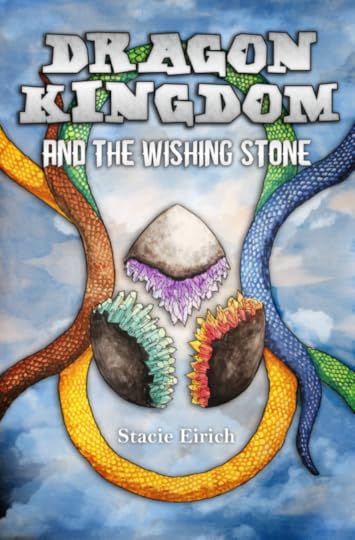
Every November, during National Novel Writing Month, thirty professional designers volunteer to create book cover art inspired by novels being written by aspiring authors from around the globe. Why? To encourage new, diverse voices, and help build a more creative world.
30 Covers, 30 Days is presented in partnership with designer and author Debbie Millman. Read more about these NaNoWriMo 2018 novels-in-progress, and the cover designers, below.
Dragon Kingdom & the Wishing StoneA Children’s novel being written this November by NaNo participant Stacie Eirich in the United States.
It is a kingdom of dreams, filled with faerie magic, shimmers with light. It is born from stories, fed with imaginations, and it is the magical place where the Wishing Stone was created. Twins Suzie & Jack and their friends Elena & Liam have taken flight to Dragon Kingdom, a magical kingdom in the sky. Their task is to find the Wishing Stone. Without its power, the good magic in the kingdom is threatened, and they may not be able to return home. Dragon Kingdom is both enchanting and dangerous, ruled by Dragon Queen Belakane and filled with colorful, winged creatures.
Suzie, Jack, Elena & Liam have help from their dragon friends Thistlefire, Brightwing, Firesong and Starlight – and meet some astonishing new beings on their journey, including a Griffin, a Sea Enchantress, and a Faerie Queene. When Suzie, Jack and their friends find out that the Wishing Stone has been broken, they embark on a quest to gather its pieces. To find them, they must solve three riddles without the aid of magic, using their intelligence, senses, strength and teamwork. Will Suzie, Jack, Liam & Elena be able to solve the riddles and restore the stone? Or will the skies of Dragon Kingdom be filled with evil Wyverns, the good magic of the Wishing Stone scattered and lost forever?
Stay tuned for new covers every day of the month!
If you’re interested in entering your novel to the 30 Covers, 30 Days program, check out the instructions here.
Cover Designed by Mark Pagano
Mark Pagano is a Raleigh, NC based artist, originally from Queens, NY. He specializes in creature paintings in oils and acrylics. Heavily influenced by folklore and mythology from around the globe, Mark Pagano uses oils, acrylics, paint markers, and found objects to bring life into these creatures. His various works have a mounted taxidermy quality to them as they stare back at you, sometimes blankly often found smiling, alive and in bold bright colors. Throughout his collection you will also find geometric elements, that are balanced and symmetrical. Dream journaling is a crucial part of his creative process. Outside of working on his art, Mark is an avid gamer, hobbyist carpenter and animal lover. He spends his free time with his wife and small arc of animal companions including 5 dogs and a cat. He hopes to greatly expand his art commission work.
You can follow Mark on Instagram @MarksArts and MarkPagano.com.
Chris Baty's Blog
- Chris Baty's profile
- 63 followers



